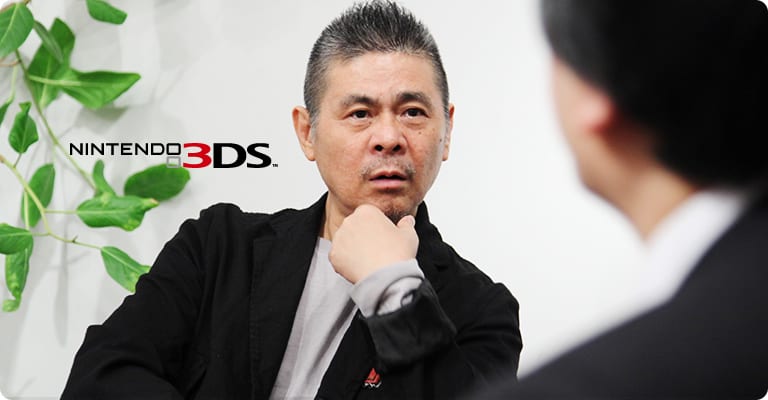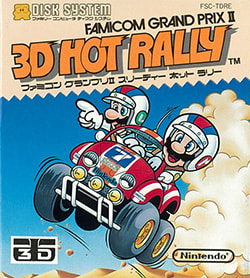Satoru Iwata Talks About Past Projects
Because of its experiences with the Virtual Boy system, Nintendo must have realized the difficulty involved in making a 3D product and conveying it properly to consumers.
That must be true. (laughs)
Mr. Iwata, you said it wouldn't be strange if Nintendo had experienced a certain trauma.
I really think so. But even though the company must have fully realized the difficulty involved in 3D products, Nintendo kept trying again and again. Even before the Nintendo 3DS system.
I didn't know that. (laughs)
(laughs)
Those products never saw the light of day.
Now that's interesting!
For example, a sample screen used in the Nintendo 3DS to illustrate how you can see three-dimensional images without special glasses was functioning on the Game Boy Advance SP system.11 11. Game Boy™ Advance SP: A handheld system released in February 2003. An upgraded version of the Game Boy™ Advance with a folding clamshell body.
Game Boy Advance SP? That's the Game Boy Advance system that opens and closes, right? So…even before Nintendo DS?
Yes, that's right. Making three-dimensional images that can be seen by the naked eye requires a special liquid crystal, so we tested it out by putting it in the Game Boy Advance SP. But the resolution of LCD was low then, so it didn't look that great and it never made it to being a product.
In order to make images look three-dimensional without special glasses, you display the images for the left and right eyes separately, and deliver each one separately. To do that you need high resolution and high-precision technology. We didn't have that to a sufficient degree back then, so the stereoscopic effect wasn't very sharp.
I see.
To go back a little further, the Nintendo GameCube12 system actually had 3D-compatible circuitry built in. 12. Nintendo GameCube: A home video game console released in September 2001.
Huh?
It had the potential for such functions.
Nintendo GameCube did? And all the Nintendo GameCubes systems around the world?
Yeah. If you fit it with a certain accessory, it could display 3D images.
What a secret!
Nintendo GameCube was released in 2001, exactly ten years ago. We'd been thinking about 3D for a long time even back then.
Why didn't anyone ever know?
The liquid crystal for it was still expensive. Simply put, Nintendo GameCube could display 3D images if you attached a special LCD, but that special liquid crystal was really expensive back then.
Yeah, we're talking about ten years ago.
We couldn't have done it without selling it for a price far above that of the Nintendo GameCube system, itself! We already had a game for it, though—Luigi's Mansion13, simultaneously released with Nintendo GameCube.
The one in which Luigi shoulders a vacuum cleaner?
Yeah, that one. We had a functional version of that in 3D. 13. Luigi's Mansion™: An action-adventure game released simultaneously with the Nintendo GameCube system in September 2001.
That was 3D?
It would jump out at you pretty nicely.
Even without special glasses, the 3D looked pretty good. But we considered how much the liquid crystal would cost, and it was just too expensive. We figured the market just wasn't there for it.
So you gave up. Whew! And now you've done it. I see! You never give up!
Yeah. We never give up. (laughs)
(laughs)
I bet the one who was most persistent in pursuing 3D was Miyamoto-san.
(laughs)
I suppose so. To go way back, I even made a 3D Famicom game on disk that you played wearing goggles. We made that with you, Iwata-san.
Right, right! (laughs) The first work Miyamoto-san and I did together was a racing game for the Family Computer Disk System14that you played wearing goggles.
Oh, really?!
A game called Famicom Grand Prix II: 3D Hot Rally.15
14. Family Computer Disk System: A peripheral product for the Famicom system released in February 1986. For media, the system used floppy disks on which software could be written.
15. Famicom Grand Prix II: 3D Hot Rally: A racing game released for the Family Computer Disk System in April 1988. It was developed by HAL Laboratory, Inc.
To explain how it happened, there was a racing game that the company Iwata-san was at, called HAL Laboratory, Inc.16, had made. HAL Laboratory had always been strong in technology, so they made a racing game with courses featuring ups and downs like you'd never seen before. But…it just wasn't fun.
Yeah.
(laughs)
They thought it was really awesome, but probably wouldn't sell the way it was, so I got involved.
In other words, you fixed it. (laughs) 16. HAL Laboratory, Inc.: A video game developer that has worked on such products as the Kirby™ and Super Smash Bros.™ series. Satoru Iwata once served this company as president.
It was a normal racing game, but I remade the overall structure of the rallies and made the main character Mario. In other words, it became a game in which Mario races a buggy around courses with a lot of intense ups and downs.
I see.
Then I thought, "Let's make that pop out." I made an image for the right eye and an image for the left eye, and…
You made special goggles with a liquid crystal shutter.
That was the first work we did together.
We had been acquainted before, but Famicom Grand Prix II: 3D Hot Rally was the first game we worked together on closely.
I don't remember that title. Did you sell it like you usually sell games?
Yeah.
A little after Kid Icarus.17
Yeah. 17. Kid Icarus™: An adventure game released for the Famicom Disk System in December 1986. A sequel named Kid Icarus: Uprising is currently under development for Nintendo 3DS.
Hmm. I guess I wasn't a video game fan.
That was before Kirby's Dream Land.18
Right. 18. Kirby's Dream Land™: An action game released for the Game Boy system in April 1992.
I remember a lot about Kirby's Dream Land. I was present once when Miyamoto-san discussed it with then-president Yamauchi.
Oh, right. (laughs)
But that's a long story and it's too much fun to talk about, so let's not go there.
(laughs)


